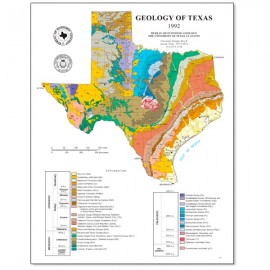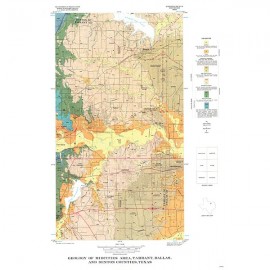Geological Circulars
-
Books & Reports
- Reports of Investigations
- Guidebooks
- Udden Series
- Geological Circulars
- Down To Earth
- Atlases of Major Oil and Gas Reservoirs
- Texas Memorial Museum Publications
- Environmental Geologic Atlas of the Texas Coastal Zone
- Mineral Resource Circulars
- Other Reports
- Seminars and Workshops
- Handbooks
- Submerged Lands of Texas
- Symposia
- Annual Reports
- Open File Reports
-
Maps & Cross Sections
- Thematic Maps
- Miscellaneous Maps, Charts & Sections
- Geologic Atlas of Texas
- STATEMAP Project Maps
- Geologic Quadrangle Maps
- Cross Sections
- Highway Geology Map
- Energy and Mineral Resource Maps
- Shoreline Change and Other Posters
- Wilcox Group, East Texas, Geological / Hydrological Folios
- Bouguer Gravity Atlas of Texas
- River Basin Regional Studies
- Featured Maps
- Posters
- Teachers & the Public
-
Geological Society Publications
- Gulf Coast Association of Geological Societies
- Alabama Geological Society
- Austin Geological Society
- Corpus Christi Geological Society
- Houston Geological Society
- Lafayette Geological Society
- Mississippi Geological Society
- New Orleans Geological Society
- South Texas Geological Society
- GCS SEPM Publications
- Historic BEG & UT Series
Potential Geothermal Resources of Texas
GC7404
A free, digital version of this publication can be found on: Texas ScholarWorks
GC7404. Potential Geothermal Resources of Texas, by M. H. Dorfman and R. O. Kehle. 33 p., 17 figs., 3 tables, 1974. ISSN: 0082-3309: Print.
To purchase this publication as a PDF download, please order GC7404D.
ABSTRACT
Geothermal energy is rapidly becoming recognized, both in the United States and abroad, as a viable source of energy which can supplement fossil fuels for electric power generation. Exploration and development of geothermal reservoirs is intensifying in the western United States and Mexico, and will l continue to expand as petroleum supplies diminish and costs increase. Although geothermal energy is commonly perceived as a new and exotic energy source, it is neither. Steam has been used for electric power generation since 1904 in Larderello, Italy, and geothermal waters have been used for space heating and agricultural purposes in other parts of the world since 1890. Geothermal power generation began in the United States in 1960 at the Geysers, California, and new fields are under development in the Salton trough of southern California.
Herein we will attempt to answer some of the basic questions about geothermal energy: what it is, how deposits are formed, and where these deposits are located. Special emphasis is placed on the potential geothermal resources of the Texas Gulf Coast and Trans-Pecos Texas. This discussion should provide the reader with an appreciation for both the problems and advantages of this unfamiliar form of energy as well as the potential it holds for supplying Texas with a portion of its future energy needs.
Keywords: geothermal energy, geothermal resources, energy, resource assessment, Texas
Citation
Dorfman, M. H., and Kehle, R. O., 1974, Potential Geothermal Resources of Texas: The University of Texas at Austin, Bureau of Economic Geology, Geological Circular 74-4, 33 p.






